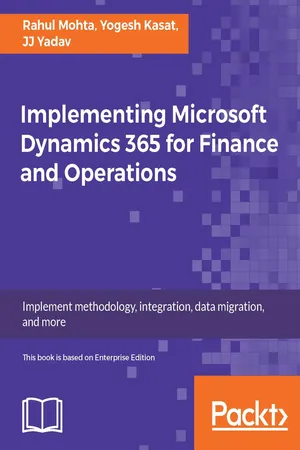
Implementing Microsoft Dynamics 365 for Finance and Operations
Rahul Mohta, Yogesh Kasat, JJ Yadav
- 562 pages
- English
- ePUB (mobile friendly)
- Available on iOS & Android
Implementing Microsoft Dynamics 365 for Finance and Operations
Rahul Mohta, Yogesh Kasat, JJ Yadav
About This Book
Harness the power of Dynamics 365 Operations and discover all you need to implement itAbout This Book• Master all the necessary tools and resources to evaluate Dynamics 365 for Operations, implement it, and proactively maintain it.• Troubleshoot your problems effectively with your Dynamics 365 partner• Learn about architecture, deployment choices, integration, configuration and data migration, development, testing, reporting and BI, support, upgrading, and more. Who This Book Is ForThis book is for technology leaders, project managers solution architects, and consultants who are planning to implement, are in the process of implementing, or are currently upgrading to Dynamics 365 for Operations. This book will help you effectively learn and implement Dynamics 365 for Operations.What You Will Learn• Learn about Microsoft Dynamics 365, it's offerings, plans and details of Finance and Operations, Enterprise edition• Understand the methodology and the tool, architecture, and deployment options• Effectively plan and manage configurations and data migration, functional design, and technical design• Understand integration frameworks, development concepts, best practices, and recommendations while developing new solutions• Learn how to leverage intelligence and analytics through Power BI, machine learning, IOT, and Cortana intelligence• Master testing, training, going live, upgrading, and how to get support during and after the implementationIn DetailMicrosoft Dynamics 365 for Finance and Operations, Enterprise edition, is a modern, cloud-first, mobile-first, ERP solution suitable for medium and large enterprise customers.This book will guide you through the entire life cycle of a implementation, helping you avoid common pitfalls while increasing your efficiency and effectiveness at every stage of the project.Starting with the foundations, the book introduces the Microsoft Dynamics 365 offerings, plans, and products. You will be taken through the various methodologies, architectures, and deployments so you can select, implement, and maintain Microsoft Dynamics 365 for Finance and Operations, Enterprise edition. You will delve in-depth into the various phases of implementation: project management, analysis, configuration, data migration, design, development, using Power BI, machine learning, Cortana analytics for intelligence, testing, training, and finally deployment, support cycles, and upgrading. This book focuses on providing you with information about the product and the various concepts and tools, along with real-life examples from the field and guidance that will empower you to execute and implement Dynamics 365 for Finance and Operations, Enterprise edition.Style and approachThis book is a step-by-step guide focusing on implementing Dynamics 365 Operations solutions for your organization.
Frequently asked questions
Information
Integration Planning and Design
- Integration architecture
- Basic integration concepts
- Integration tools, midleware, and scenarios
- Dynamics 365 data integrator
- Integration planning
- Integration design and development
- Best practices and recommendations
Integration architecture
- SOAP message exchanges are bulky and not suitable for cloud-based integration
- The AIF framework has performance overhead
- The duplication of business logic due to different frameworks for integration (AIF) and data management (DIXF)

Basic integration concepts
RESTful APIs
- Base URL: Such as http://YourDynamics365ForOperationsURL/data/
- Media type: Such as application/JSON and application/XML
- Standard HTTP methods: Such as GET, PUT, POST, and DELETE
SOAP
